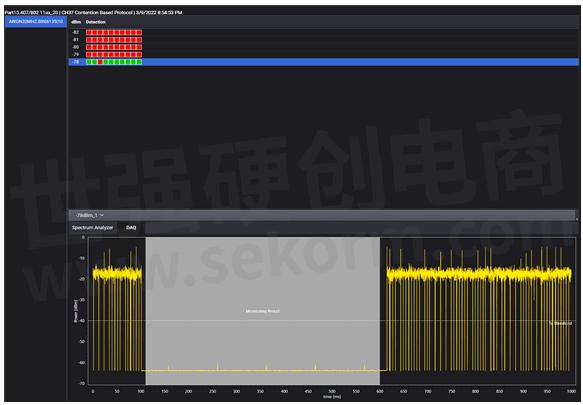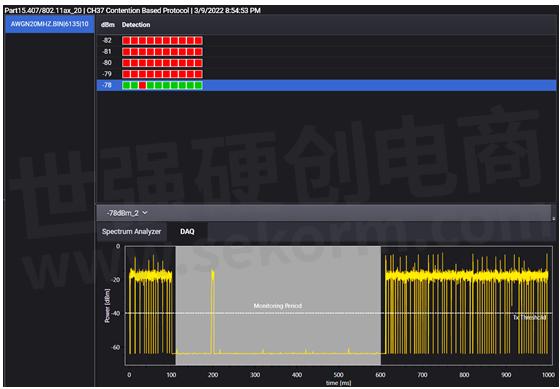Wi-Fi 6E Matters: What Is Contention-Based Protocol Test?

Every wireless device must obtain approval from the Federal Communications Commission (FCC) before it can be launched in the U.S. and many other countries around the world that follow the FCC. When it comes to Wi-Fi 6E devices, the FCC approved using the 6GHz band by unlicensed users in April 2020. Two types of access points (AP) can use the band: low-power indoor APs, and standard-power devices, which will emerge during the second phase of the standard rollout.
Low-power indoor devices can use the entire 6GHz band while standard-power APs can only use the Unlicensed National Information Infrastructure (U-NII) 5 and U-NII-7 bands. Using U-NII 5-8 bands does not require a license, but many users already use this spectrum including 5G cellular, other Wi-Fi access points, satellite links, mobile TV broadcasts, and utility communication links, and incumbent carriers have priority over other users. That’s when contention-based protocol (CBP) comes into the picture.
With incumbent carriers taking priority over other users in the 6GHz spectrum, Wi-Fi 6E devices must use a CBP to prevent interference with their services. All equipment classes – APs and clients - must undergo testing for CBP and pass this test, although the test limits differ between classes, especially for future standard-power devices, which are higher-power with elevation restrictions.
CBP Test Setup Overview
A CBP test setup involves two signal analyzers and an additive white Gaussian noise (AWGN) signal source to produce a 10 MHz-wide noise for the test signal. You will also need a client device to communicate with the test device during the testing process, which is not shown in Figure 1, and signal conditioning components.

Figure 1. CBP conducted a test setup diagram. Source: KDB 987594 D02 V01r01
Be prepared to perform multiple measurements at a calibrated signal level to achieve the 90% detection rate required by the test. You don't have to worry about the time it takes the device to detect and stop the transmission though. There are no tolerances for detecting the incumbent signal. The focus is solely on testing the device's ability to perform the necessary actions.
CBP Measurement Examples
Figure 2 provides an example of passing results for FCC CBP testing of a Wi-Fi 6E router with 20MHz of channel bandwidth. The test process started by checking if the device could detect the incumbent signal at -82dBm. We then repeated the same test until hitting a 90% detection rate. You need to test at least one channel per UNII band with a 20MHz bandwidth and AWGN signal at three different frequencies in-band for 160MHz bandwidth.

Figure 2. Example of passing FCC CBP test results for a Wi-Fi 6E router from Keysight's XA5002A FCC test software for a 20MHz channel
Figure 3 shows failed results for the device because a burst happened during the monitoring window, which shows up in the data acquisition (DAQ) tab.

Figure 3. Failed FCC CBP test results for a Wi-Fi 6E router from Keysight's XA5002A FCC test software for a 20MHz channel
CBP testing is a key but only one of the major differences in FCC standards for Wi-Fi 6E devices you should know about if you are involved in regulatory testing for these devices.
- +1 Like
- Add to Favorites
Recommend
- Keysight Technologies Acquires Quantum Benchmar, Augmenting Keysight‘s Quantum Portfolio
- Keysight First to Gain OmniAir Qualified Test Equipment Status, Accelerating C-V2X Device Certification
- Keysight First to Gain GCF Approval of Cases for Validating 5G New Radio mmWave Devices in Standalone Mode
- Keysight Massively Parallel Board Test System Selected by LACROIX in Automotive Printed Circuit Board Manufacturing
- Keysight, TIM and JMA Wireless Join Forces to Showcase O-RAN Technology at Mobile World Congress 2021
- Keysight, Xilinx and Cisco Showcase Solutions that Support Smooth Migration from 4G LTE Networks to 5G Open RAN
- Keysight Unveils the First Media Access Control Security Test Solution for High Speed Ethernet
- Keysight, MediaTek Join Forces to Establish 5G Connectivity Based on 3GPP Release 16 Specifications
This document is provided by Sekorm Platform for VIP exclusive service. The copyright is owned by Sekorm. Without authorization, any medias, websites or individual are not allowed to reprint. When authorizing the reprint, the link of www.sekorm.com must be indicated.















































































































































































































































































































































































































































































































































































































































































































































































































































